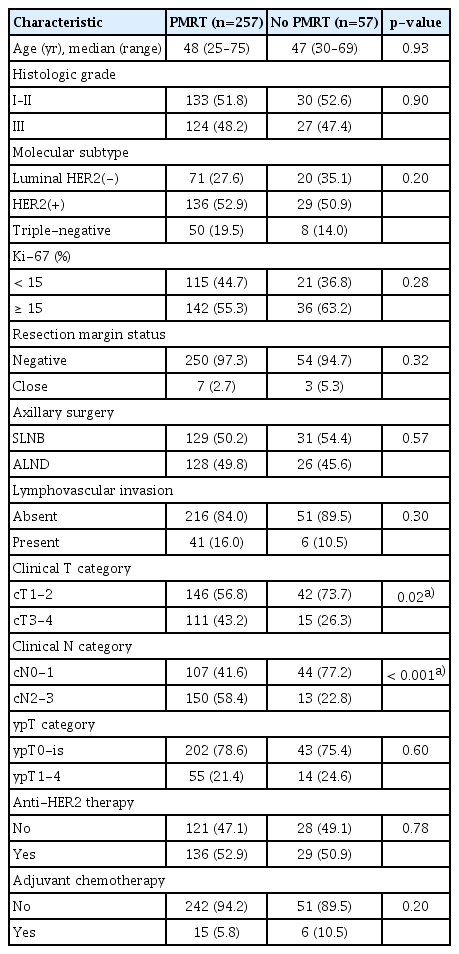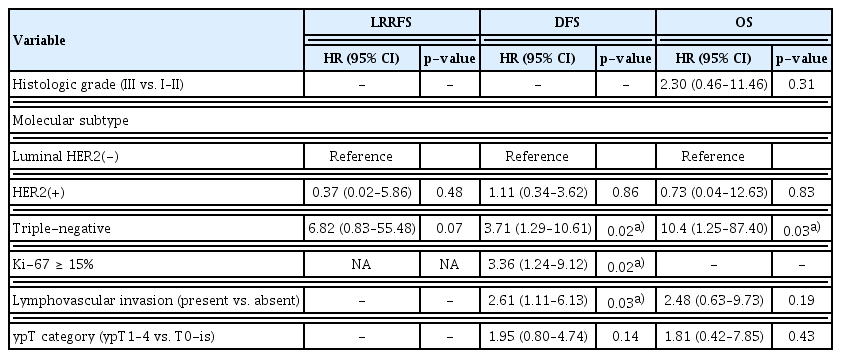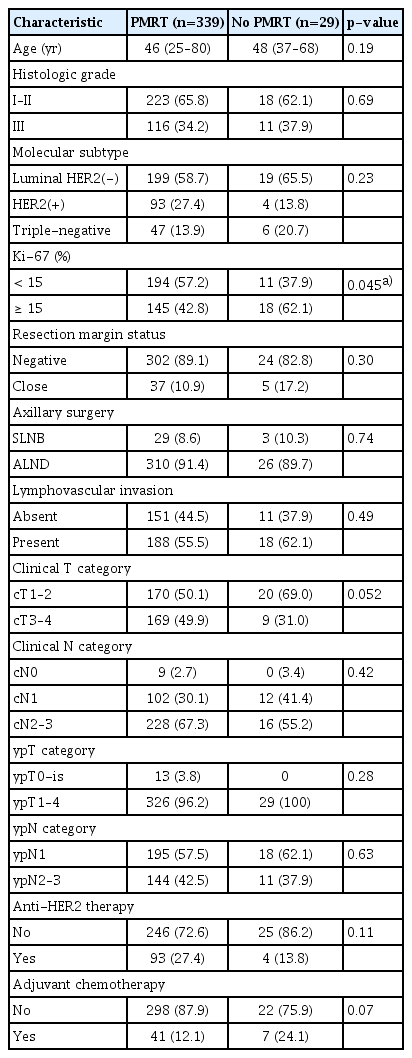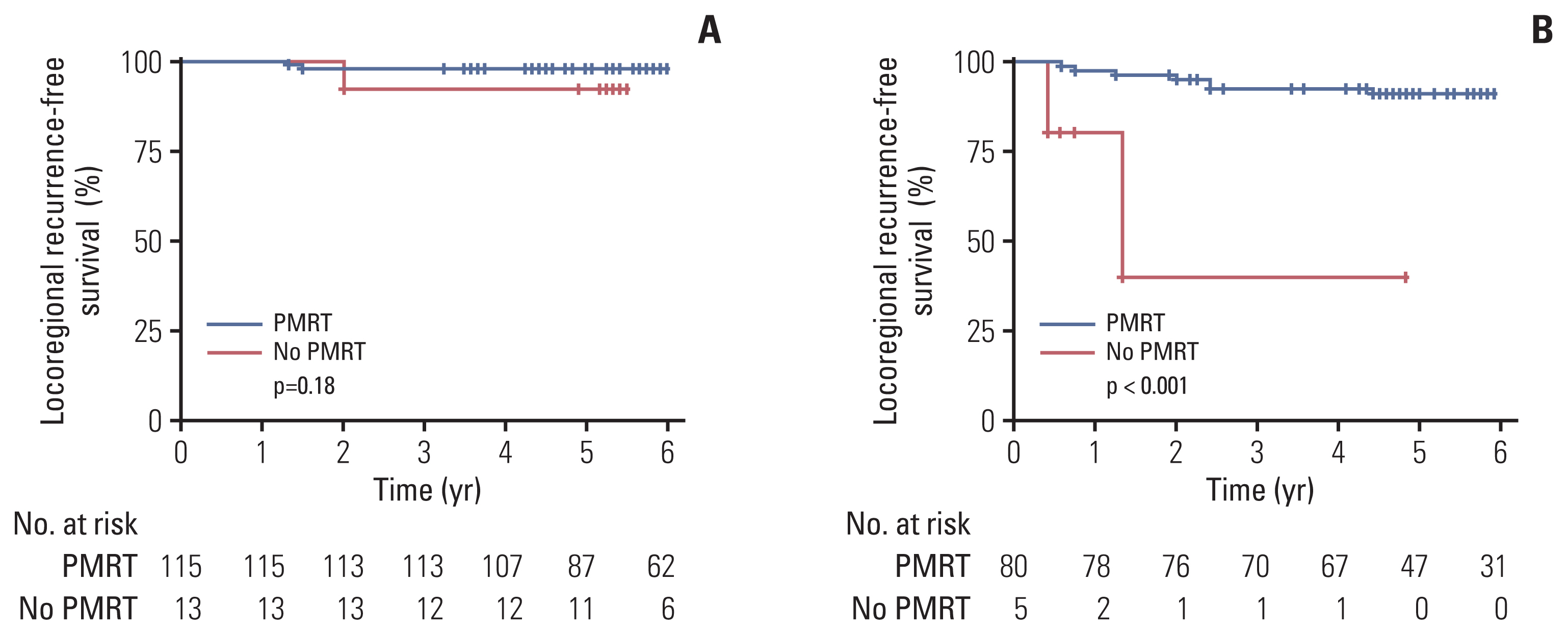Impact of Postmastectomy Radiation Therapy on Breast Cancer Patients According to Pathologic Nodal Status after Modern Neoadjuvant Chemotherapy
Article information
Abstract
Purpose
The utility of postmastectomy radiation therapy (PMRT) for breast cancer patients after neoadjuvant chemotherapy (NAC) is highly controversial. This study evaluated the impact of PMRT according to pathologic nodal status after modern NAC.
Materials and Methods
We retrospectively reviewed 682 patients with clinical stage II–III breast cancer who underwent NAC and mastectomy from 2013 to 2017. In total, 596 patients (87.4%) received PMRT, and 86 (12.6%) did not. We investigated the relationships among locoregional recurrence-free survival (LRRFS), disease-free survival (DFS), overall survival (OS), and various prognostic factors. Subgroup analyses were also performed to identify patients who may benefit from PMRT.
Results
The median follow-up duration was 67 months. In ypN+ patients (n=368, 51.2%), PMRT showed significant benefits in terms of LRRFS, DFS, and OS (all p < 0.001). In multivariate analyses, histologic grade (HG) III (p=0.002), lymphovascular invasion (LVI) (p=0.045), and ypN2–3 (p=0.02) were significant risk factors for poor LRRFS. In ypN1 patients with more than two prognostic factors among luminal/human epidermal growth factor receptor-2–negative subtype, HG I–II, and absence of LVI, PMRT had no significant effect on LRRFS (p=0.18). In ypN0 patients (n=351, 48.8%), PMRT was not significantly associated with LRRFS, DFS, or OS. However, PMRT showed better LRRFS in triple-negative breast cancer (TNBC) patients (p=0.03).
Conclusion
PMRT had a major impact on treatment outcomes in patients with residual lymph nodes following NAC and mastectomy. Among ypN0 patients, PMRT may be beneficial only for those with TNBC.
Introduction
Neoadjuvant chemotherapy (NAC) is widely used in patients with locally advanced breast cancer and is an effective treatment for early-stage breast cancer patients [1,2]. NAC decreases tumor size, has a relatively high rate of breast preservation, and allows for early evaluation of the sensitivity of tumor cells to systemic therapy [3,4]. Recently, neoadjuvant anti-human epidermal growth factor receptor-2 (HER2) therapy in combination with NAC has been used in HER2-positive patients, and improved treatment responses [5,6]. Selecting the optimal treatment after neoadjuvant therapy is important, given the increasing use of NAC for breast cancer patients. Several studies found that postmastectomy radiation therapy (PMRT) significantly reduces the locoregional recurrence (LRR) rate and improves overall survival (OS) in stage II–III breast cancer patients [7,8]. However, the role of PMRT after NAC has not yet been established, and current guidelines recommend that the decision to use PMRT be based on the clinical stage prior to NAC [9].
In previous studies, residual lymph node (LN) disease (ypN+) was an unfavorable prognostic factor [10–12]. In ypN+ patients, PMRT showed a significant survival benefit; hence, PMRT is currently recommended regardless of the number of residual LNs. However, studies analyzing the effects of PMRT on patients with minimal residual LN involvement (e.g., ypN1 patients) are lacking. Retrospective studies have reported the effectiveness of PMRT in patients with no residual LNs (ypN0) undergoing NAC and mastectomy [13–17]. Most studies did not show any survival benefit of PMRT for ypN0 patients [13–15]. However, some reported that PMRT effectively reduced LRR, even in ypN0 patients [16,17]. Therefore, the need for PMRT in ypN0 patients remains controversial.
This study evaluated the effect of PMRT after NAC according to the pathologic nodal stage. Additionally, we conducted subgroup analyses to identify patients who may significantly benefit from PMRT.
Materials and Methods
1. Patients
We retrospectively reviewed 807 patients with clinical stage II–III breast cancer who underwent NAC and mastectomy at two institutions between January 2013 and December 2017. We excluded patients with inflammatory or bilateral breast cancer, clinically positive supraclavicular or internal mammary LNs, distant metastases, prior chemotherapy or radiation therapy (RT), or a previous or concurrent malignancy (except for thyroid cancer). Ultimately, 682 patients were included. We classified the patients into three subtypes based on immunohistochemistry (IHC): luminal/HER2-negative (estrogen receptor [ER]− or progesterone receptor [PR]–positive), HER2-positive (regardless of hormone receptor status), and triple-negative breast cancer (TNBC) (ER−, PR−, and HER2-negative). HER2 overexpression was defined as an IHC staining score of 3+ or 2+, based on fluorescence in situ hybridization or a silver in situ hybridization test.
The clinical stage was determined by physical examination and imaging tests. All patients underwent mammography and breast ultrasound before treatment initiation, and regional LNs were also assessed by ultrasound. Of the patients with suspicious LNs (n=672), 42.4% (n=285) were pathologically confirmed by ultrasound-guided fine-needle aspiration, and the remainder were clinically determined by imaging tests (magnetic resonance imaging or positron emission tomography).
2. Treatment
All patients received NAC. The most commonly used NAC regimen was anthracycline plus taxanes in 540 patients (79.2%), followed by a taxane-based regimen in 115 patients (16.9%), an anthracycline-based regimen in 25 patients (3.7%), and “other” regimens in two patients (0.2%). The median number of NAC cycles was eight (range, 2 to 12 cycles). Most patients completed the planned NAC, while sixteen did not complete it. The reasons for not completing NAC were (1) no response or increase in tumor size during chemotherapy (n=9), (2) severe chemotherapy-related toxicity (n=4), and (3) patient preference (n=3). Most patients with HER2-positive disease (242/262, 92.3%) received neoadjuvant anti-HER2 therapy combined with NAC regimens, i.e., doxorubicin plus cyclophosphamide followed by paclitaxel plus trastuzumab (n=167); trastuzumab, pertuzumab, carboplatin, and docetaxel (n=71); or paclitaxel and trastuzumab (n=4).
All patients underwent mastectomy following NAC. Axillary LN dissection and sentinel lymph node biopsy (SLNB) alone were performed in 490 (71.8%) and 192 (28.2%) patients, respectively. The median number of LNs dissected was 14 (range, 1 to 58 LNs). Adjuvant chemotherapy was provided for 69 patients (10.1%). The most common adjuvant chemotherapy regimen was capecitabine (n=30, 4.4%), followed by a taxane-based regimen (n=13, 1.9%). Most patients with hormone receptor–positive tumors (98.7%, 444/450) received adjuvant endocrine therapy. All patients with HER2-positive disease (n=262) received adjuvant anti-HER2 therapy after surgery.
PMRT was performed in 596 patients (87.4%). RT was administered as either conventional fractionation (1.8–2.0 Gy/fraction) or hypofractionation (2.4–2.7 Gy/fraction). The radiation oncologist determined the dose fractionation scheme; 298 patients (50.0%) underwent conventional fractionated RT and 298 (50.0%) underwent hypofractionated RT. In total, 578 patients (97.0%) received regional nodal irradiation; RT was delivered to the supraclavicular fossa in 570 patients and internal mammary nodes in 181 patients. The median radiation dose to the chest wall, axilla, and regional nodes was 50.4 Gy (range, 48.6 to 66 Gy) for conventional fractionated RT and 45.9 Gy (range, 40.5 to 55.2 Gy) for hypofractionated RT. RT was delivered using three-dimensional conformal RT (n=279, 46.8%) or intensity-modulated RT (n=317, 53.2%).
3. Statistical analysis
Categorical variables were compared between groups according to PMRT using the chi-square test or Fisher exact test. Student’s t test was used for continuous variables. LRR was defined as disease recurrence within the ipsilateral chest wall or ipsilateral regional lymphatic area (axillary, internal mammary, or supraclavicular LNs). Locoregional recurrence-free survival (LRRFS) was defined as the time from the initiation of NAC to the first LRR. Disease-free survival (DFS) was defined as the time from the initiation of NAC to the date of relapse or death. OS was the time from the initiation of NAC to the date of death from any cause. Survival curves were generated using the Kaplan-Meier method and compared using the log-rank test. Cox regression univariate and multivariate analyses were used to identify prognostic factors. A p-value < 0.05 was taken to indicate statistical significance. Variables with a p-value < 0.05 in the univariate analysis were included in the multivariate analysis. All statistical analyses were performed with STATA software ver. 17.0 (Stata Corp., College Station, TX).
Results
1. Entire cohort
The median follow-up duration was 67 months (range, 9 to 106 months). The clinical and pathologic characteristics of the entire cohort are presented in S1 Table. The median age at diagnosis was 47 years (range, 25 to 80 years). Among the 682 patients, there were 309, 262, and 111 with luminal/HER2-negative, HER2-positive, and TNBC status, respectively. We defined pathologic complete response (ypCR) as no residual invasive cancer in the breast or axilla after NAC. Also, we included 64 patients with residual ductal carcinoma in situ in the ypCR group (ypTis/0N0). A total of 135 patients (19.8%) achieved ypCR. S2 Table lists the ypCR rates according to molecular subtype. The ypCR rates of the luminal/HER2-negative, HER2-positive, and TNBC patients were 5.8%, 37.4%, and 17.1%, respectively. HER2-positive and TNBC patients showed significantly higher rates of ypCR than luminal/HER2-negative patients (p < 0.001 and p=0.001, respectively).
In total, 314 patients (46.0%) were pathological node-negative (ypN0), 213 (31.2%) had 1–3 positive LNs (ypN1), and 155 (22.7%) had > four positive LNs (ypN2–3). The ypN0 rates were 29.4% (91/309), 62.9% (165/262), and 52.2% (58/111) for the luminal/HER2-negative, HER2-positive, and TNBC subtypes, respectively. S3 Fig. shows the LRRFS curves according to pathologic nodal stage. The 5-year LRRFS rates of the ypN0, ypN1, and ypN2–3 patients were 97.4%, 94.3%, and 88.8%, respectively. Compared to ypN0, the ypN2–3 patients showed significantly low LRRFS (p < 0.001); however, the ypN1 patients did not show a significant difference (p=0.12).
2. ypN0 patients
Of the 314 patients with ypN0 after NAC and mastectomy, 257 (81.8%) received PMRT and 57 (18.2%) did not. The clinicopathological characteristics of the ypN0 patients are listed in Table 1. Patients who received PMRT were significantly more likely to have an advanced clinical T category (43.2% vs. 26.3%, p=0.02) and N category (58.4% vs. 22.8%, p < 0.001). However, there were no significant differences for any other variables. The patterns of treatment failure in ypN0 patients are detailed in S4 Table. Overall, nine patients (2.9%, 9/314) experienced LRR; one (1.1%, 1/91) was luminal/HER2-negative, one (0.6%, 1/165) was HER2-positive, and seven (12.1%, 7/58) were of the TNBC subtype. All but three of the patients with the TNBC subtype received PMRT. The median time to LRR was 12 months (range, 5 to 50 months).
In the univariate analysis, TNBC subtype was an unfavorable prognostic factor for LRRFS, DFS, and OS (all p < 0.001) (S5 Table). In the multivariate analysis, TNBC subtype was associated with significantly inferior DFS and OS (p=0.02 and p=0.03, respectively) (Table 2); there was also a trend toward inferior LRRFS for the TNBC subtype (p=0.07).
Subgroup analyses were performed to identify patients who might benefit from PMRT (Fig. 1). PMRT was not associated with improved LRRFS in most ypN0 patients; however, in ypN0 patients with the TNBC subtype, PMRT was associated with a significantly improved 5-year LRRFS (91.9% vs. 75.0%, p=0.03).

Subgroup analyses of LRRFS according to the use of PMRT in ypN0 patients. ALND, axillary lymph node dissection; HER2, human epidermal growth factor receptor; LRRFS, locoregional recurrence-free survival; NA, not available; PMRT, postnastectomy radiation therapy; RT, radiation therapy; SLNB, sentinel lymph node biopsy. a)Significant p-value.
3. ypN+ patients
Of the 368 patients with ypN+, 339 (92.1%) received PMRT and 29 (7.9%) did not. The clinicopathological characteristics of the ypN+ patients are summarized in Table 3. Most variables did not show significant differences between the two groups, although the prevalence of a high Ki-67 index (≥ 15%) was higher in the no-PMRT group (62.1% vs. 42.8%, p=0.045). Patterns of treatment failure in the ypN+ patients are detailed in S6 Table. Thirty patients (8.2%) experienced LRR; twelve (5.5%, 12/218) were luminal/HER2-negative, eight (8.2%, 8/97) were HER2-positive, and ten (18.9%, 10/53) were of the TNBC subtype. The median time to LRR was 13 months (range, 2 to 72 months).
The results of the univariate analysis performed to identify prognostic factors for LRRFS, DFS, and OS are shown in S7 Table. In the multivariate analysis, PMRT was a favorable prognostic factor for LRRFS, DFS, and OS (all p < 0.001) (Table 4). Histologic grade (HG) III, TNBC subtype, lymphovascular invasion (LVI), clinical stage T3–4, and ypN2–3 had a significant adverse effect on DFS and OS. Furthermore, HG III (p=0.002), LVI (p=0.045), and ypN2–3 (p=0.02) were associated with inferior LRRFS. The TNBC subtype had a marginally significant effect on LRRFS (p=0.09).
In the subgroup analyses, PMRT significantly improved LRRFS in all subsets of ypN+ patients (Fig. 2). We also aimed to identify a specific subgroup of ypN1 patients for whom PMRT did not affect LRRFS. We defined risk groups using the risk factors identified in multivariate analysis of LRRFS in ypN+ patients. The three risk factors were molecular subtype (others vs. luminal/HER2-negative), HG (III vs. I–II), and LVI (present vs. absent). We defined patients with 0–1 risk factors as low risk and those with 2–3 risk factors as high risk. Of the low-risk patients (n=128), 115 (89.8%) received PMRT and 13 (10.2%) did not. Of the high-risk patients (n=85), 80 (94.1%) underwent PMRT and five (5.9%) did not. Fig. 3 shows the difference in LRRFS according to PMRT in each risk group of ypN1 patients. In the low-risk group, there was no significant difference in 5-year LRRFS according to PMRT (92.3% vs. 98.3%, p=0.18). However, in the high-risk group, PMRT significantly improved the 5-year LRRFS (40% vs. 90.7%, p < 0.001).

Subgroup analyses of LRRFS according to the use of PMRT in ypN+ patients. ALND, axillary lymph node dissection; HER2, human epidermal growth factor receptor; LRRFS, locoregional recurrence-free survival; NA, not available; PMRT, postmastectomy radiation therapy; RT, radiation therapy; SLNB, sentinel lymph node biopsy. a)Significant p-value.
Discussion
NAC is commonly performed in stage II–III breast cancer patients [1,2]. The indications for adjuvant PMRT in patients receiving NAC and mastectomy remain controversial due to a lack of prospective data. Current guidelines recommend that PMRT be performed based on the disease stage at the time of diagnosis [9]. However, studies have shown that patients who respond well to NAC have a better prognosis regardless of clinical stage and questioned whether PMRT is necessary for these patients [13,14]. Moreover, the decision to perform PMRT is more complicated in patients with few residual LNs, such as ypN1 [18]. Without PMRT, LRR rates of 10%–20% for patients with ypN1 and < 10% for those with ypN0 have been recently reported [12,13,19]. Therefore, the role of PMRT in patients receiving upfront systemic therapy must be evaluated in more detail. This study evaluated the treatment outcomes of patients who received NAC according to the pathologic nodal stage. We focused on identifying subgroups in which PMRT could reduce the risk of LRR.
Almost 80% of breast cancer patients show a response to NAC, as reported in National Surgical Adjuvant Breast and Bowel Project Protocols B-18 and B-27 [20]. In a study based on the National Cancer Database that analyzed the response to NAC of breast cancer patients, the overall ypCR rate was 19%; the highest ypCR rate was observed in the HER2-positive subtype (38.7%), followed by the TNBC (23.2%) and luminal (8.6%) subtypes [21]. These results are similar to those of our study, in which the ypCR rate was highest in the HER2-positive subtype, followed by the TNBC subtype. A meta-analysis of 29 prospective studies showed that ypCR after neoadjuvant treatment in breast cancer is a powerful prognostic factor [22]. Although a tumor response is generally associated with improved survival, this relationship is most robust for the TNBC and HER2-positive subtypes [23]. Hence, a high rate of LRR is not guaranteed when there is a residual disease after NAC. In our study, the rate of complete nodal response to modern NAC was highest in the HER2-positive subtype (63.0%, 165/262) and lowest in the luminal/ HER2-negative subtype (29.4%, 91/309). However, ypN0 and ypN+ patients belonging to these two subtypes showed the lowest LRR, regardless of PMRT. In other words, the benefits of PMRT may be relatively limited for the luminal/HER2-negative subtype compared to other subtypes, among patients with residual LN after NAC. Although long-term follow-up is required to evaluate the LRR in the luminal type (especially in ER+ patients), the pathological nodal status after NAC alone may be insufficient to indicate the need for PMRT [24,25].
Several studies showed that residual LNs after NAC and mastectomy are a poor prognostic factor for LRR, and PMRT appears to be associated with better survival in ypN+ patients [10–12]. The current guidelines recommend adjuvant PMRT for patients with any ypN+ disease, regardless of the number of residual LNs [9]. Zhang et al. [10] assessed LRR and DFS in 544 patients who underwent NAC and mastectomy, and demonstrated that LRR gradually increased with the number of residual LNs. Also, in the ypN1 and ypN2–3 cohorts, PMRT significantly improved LRR and DFS. However, recently, some authors insisted that PMRT can be omitted in ypN1 patients [19,26]. Miyashita et al. [19] reported a survival benefit of PMRT only in ypN2–3 patients, and that there was no difference in LRR, DFS, or OS according to PMRT in ypN1 patients. It has also been suggested that the neoadjuvant response index (NRI) be used for assessing the treatment response rather than binary outcomes, such as ypN+ and ypN0. Using the NRI, Lee et al. [27] showed that PMRT had little impact on the LRRFS and OS of patients who responded well to NAC (NRI of 0.7–1.0).
In this study, PMRT conferred a survival benefit for the entire ypN+ group. In the multivariate analysis, ypN2–3 patients showed significantly worse LRRFS, DFS, and OS than those with ypN1. In subgroup analysis, although PMRT was associated with a significantly improved LRR in ypN1 patients, the difference in 5-year LRRFS according to PMRT was more prominent in the ypN2–3 than ypN1 group (48.6% vs. 13.4%, respectively) (Fig. 2). These results demonstrate a difference in the response to RT between the two groups, even among patients with residual LNs after NAC. Thus, we considered it necessary to validate the effectiveness of PMRT by stratifying ypN1 patients according to the risk of LRR. Interestingly, and consistent with previous studies, there was no significant difference in LRRFS with versus without PMRT in the low-risk ypN1 patients. Therefore, in ypN1 patients, we suggest that the decision to perform PMRT should consider risk factors for LRR such as HG (HG III vs. HG I–II), LVI (present vs. absent), and molecular subtype (others vs. luminal/HER2-negative).
Several retrospective studies have evaluated whether PMRT can be omitted in ypN0 patients [13–17]. Shim et al. [13] analyzed the effects of PMRT in 151 patients with ypN0 who underwent NAC and mastectomy; PMRT did not have a significant impact on survival outcomes. The authors also suggested that PMRT may not be necessary for pN0 patients after NAC, regardless of clinical stage. Cho et al. [14] investigated the impact of PMRT according to molecular subtype in a study of 189 patients who achieved ypN0; PMRT did not show an additional survival benefit for any subtype. However, in a large retrospective study of 4,235 breast cancer patients who underwent NAC and total mastectomy, PMRT significantly improved LRRFS in ypT0, ypN0, and ypCR patients compared to the no-PMRT group [16]. Given these results, whether PMRT has a survival benefit for patients without residual LN remains unclear, especially for locoregional control, compared to no-PMRT patients. The equivocal results may be partially explained by the difference in relative proportions of ypN0 molecular subtypes among the studies. In our study, neoadjuvant anti-HER2 therapy was performed in most HER2-positive patients; correspondingly, patients with HER2-overexpression accounted for a higher percentage of the ypN0 group than in previous studies.
We also showed that PMRT had no survival benefit for ypN0 patients. However, in subgroup analysis, PMRT was associated with better LRRFS compared with the no-PMRT group of ypN0 patients with the TNBC subtype. Few studies have analyzed the effects of PMRT on LRR in specific subsets of patients. However, similar to our results, several studies have reported that the TNBC subtype can increase LRR [28]. Wright et al. [28] reported that, among 464 breast cancer patients who underwent NAC and PMRT, there were nine cases of regional recurrence, of which seven were of the TNBC subtype. Moreover, TNBC was an independent predictor of LRR. In addition, HER2 overexpression did not emerge as a risk factor for LRR, where most patients with HER2-positive disease received neoadjuvant HER2-targeted therapy. Furthermore, Jeon et al. [29] reported that anti-HER2 therapy improved LRR in HER2-overexpressing breast cancer patients; although this study was conducted in the adjuvant setting, it is noteworthy because it assessed the effectiveness of anti-HER2 therapy for locoregional control. The results were consistent with our findings, where the rate of LRR was lowest in the HER2-positive ypN0 patients. Therefore, we suggest that molecular subtype should be a major consideration when deciding whether to omit PMRT in ypN0 patients.
There were several limitations to our study. First, it used a retrospective design, PMRT was administered at the physician’s discretion, and there may have been selection bias. Second, the follow-up period was relatively short because we only included patients who underwent modern neoadjuvant treatment at our institution. Further studies are needed to obtain long-term follow-up data. Third, we cannot fully exclude the possibility of false-positive or -negative findings regarding nodal stage. Only 285 patients had biopsy-proven LN at diagnosis; the remaining cN+ patients may have had false-positive imaging results for LNs. Additionally, the ypN0 rate was higher than in previous studies [10,30]. The results may not only reflect the effect of modern neoadjuvant systemic treatment, but also the fact that SLNB alone was performed relatively more frequently than in other studies, resulting in false-negative ”ypN0 status” results [13,14]. Lastly, the size of some pathologic nodal stage and PMRT status subgroups was small. In particular, the number of patients in the high-risk ypN1 group was low, thus limiting the power of the analysis. However, the results for the high-risk group were less important, because we focused on the low-risk group (in which PMRT was less effective). In addition, in ypN+ patients, there were no statistically significant differences in patient characteristics between PMRT and no-PMRT groups; however, patients without PMRT accounted for a very small proportion, so we could not completely exclude a hidden selection bias in this study. The main strength of this study was that it included most patients who had undergone modern neoadjuvant treatment at our institution, and performed subgroup analyses according to pathologic nodal status.
In this study, PMRT significantly improved survival outcomes in patients with residual LNs after modern neoadjuvant treatment. However, PMRT may have no benefit with respect to LRRFS in ypN1 patients with two or more prognostic factors, including luminal/HER2-negative and HG I–II patients, and those without LVI. In ypN0 patients, survival outcomes did not differ significantly according to PMRT. Nevertheless, PMRT might improve LRRFS in TNBC subtype ypN0 patients.
Electronic Supplementary Material
Supplementary materials are available at Cancer Research and Treatment website (https://www.e-crt.org).
Notes
Ethical Statement
The institutional review boards of all the participating institutions approved this study. The requirement for informed consent was waived due to the retrospective study design.
Author Contributions
Conceived and designed the analysis: Kim D, Shin KH.
Collected the data: Kim D, Kim JH, Kim IA, Chang JH, Shin KH.
Contributed data or analysis tools: Kim D, Shin KH.
Performed the analysis: Kim D, Shin KH.
Wrote the paper: Kim D, Kim JH, Kim IA, Chang JH, Shin KH.
Conflicts of Interest
Conflict of interest relevant to this article was not reported.
Acknowledgments
This work was supported by the National R&D Program for Cancer Control through the National Cancer Center (NCC) funded by the Ministry of Health & Welfare, Republic of Korea (HA22C0044).





